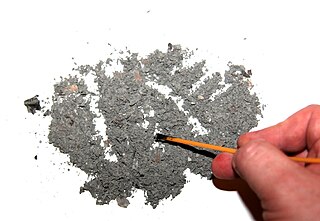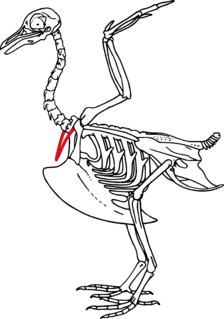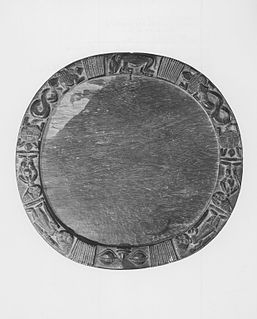Sources
- Mackay, C. (2019). Extraordinary Popular Delusions and the Madness of Crowds: Vol.1-3. e-artnow.
| |||||||||||||||
Sternomancy, from the Greek sternon (chest) is a divination practice involving reading the markings or bumps on the chest or breast bone (or the area "from the breast to the belly", according to some sources). Sternomancy may have been commonly practiced on victims of sacrifice, including human sacrifice. Sternomancy may also include speaking through the chest (believed to be an early form of ventriloquism).
The size and shape of the sternum bone are taken into consideration, as well as the way in which the bone burns when placed into a fire. The old holiday custom of the breaking of a chicken's or turkey's wishbone by two persons is actually a remnant of this type of divination.
Sternomancy is related to phrenology (head-reading), palmistry (chiromancy) and scapulomancy (divination by observing animal shoulder-blades).

The breast is one of two prominences located on the upper ventral region of a primate's torso. Both females and males develop breasts from the same embryological tissues.

Divination is the attempt to gain insight into a question or situation by way of an occultic, standardized process or ritual. Used in various forms throughout history, diviners ascertain their interpretations of how a querent should proceed by reading signs, events, or omens, or through alleged contact with a supernatural agency.

The Shang dynasty, also known as the Yin dynasty, was a Chinese royal dynasty that ruled in the Yellow River valley in the second millennium BC, traditionally succeeding the Xia dynasty and followed by the Western Zhou dynasty. The classic account of the Shang comes from texts such as the Book of Documents, Bamboo Annals and Records of the Grand Historian. According to the traditional chronology based on calculations made approximately 2,000 years ago by Liu Xin, the Shang ruled from 1766 to 1122 BC, but according to the chronology based upon the "current text" of Bamboo Annals, they ruled from 1556 to 1046 BC. The Xia–Shang–Zhou Chronology Project dated them from c. 1600 to 1046 BC based on the carbon-14 dates of the Erligang site.

Fortune telling is the practice of predicting information about a person's life. The scope of fortune telling is in principle identical with the practice of divination. The difference is that divination is the term used for predictions considered part of a religious ritual, invoking deities or spirits, while the term fortune telling implies a less serious or formal setting, even one of popular culture, where belief in occult workings behind the prediction is less prominent than the concept of suggestion, spiritual or practical advisory or affirmation.

In the religion of ancient Rome, a haruspex was a person trained to practise a form of divination called haruspicy (haruspicina), the inspection of the entrails of sacrificed animals, especially the livers of sacrificed sheep and poultry. The reading of omens specifically from the liver is also known by the Greek term hepatoscopy.

Oracle bones are pieces of ox scapula and turtle plastron, which were used for pyromancy – a form of divination – in ancient China, mainly during the late Shang dynasty. Scapulimancy is the correct term if ox scapulae were used for the divination, plastromancy if turtle plastrons were used.

Oracle bone script was an ancestor of modern Chinese characters engraved on oracle bones—animal bones or turtle plastrons used in pyromantic divination—in the late 2nd millennium BC, and is the earliest known form of Chinese writing. The vast majority, amounting to about 150,000 pieces, were found at the Yinxu site located in Xiaotun Village, Anyang City, Henan Province. The latest significant discovery is the Huayuanzhuang storage of 1,608 pieces, 579 of which were inscribed, found near Xiaotun in 1993. They record pyromantic divinations of the last nine kings of the Shang dynasty, beginning with Wu Ding, whose accession is dated by different scholars at 1250 BC or 1200 BC. After the Shang were overthrown by the Zhou dynasty in c. 1046 BC, divining with milfoil became more common, and a much smaller corpus of oracle bone writings date from the Western Zhou. Thus far, no Zhou sites have been found with a cache of inscriptions on the same scale as that at Yinxu, although inscribed oracle bones appear to be more widespread, being found near most major population centers of the time, and new sites have continued to be discovered since 2000.

Spodomancy is a form of divination by examining cinders, soot, or ashes, particularly although not exclusively from a ritual sacrifice. Spodomancy has been practiced by numerous cultures, ancient and modern, across the globe. While many practitioners have performed the ritual as part of a formal system of paranormal, religious, or ceremonial magic, many have done so as part of mere folkloric practice or superstition.
Cowrie-shell divination refers to several distinct forms of divination using cowrie shells that are part of the rituals and religious beliefs of certain religions. Though best-documented in West Africa as well as in Afro-American religions, such as Santería, Candomblé, and Umbanda, cowrie-shell divination has also been recorded in India, East Africa, and other regions.

Alectryomancy is a form of divination in which the diviner observes a bird, several birds, or most preferably a white rooster or cockerel pecking at grain that the diviner has scattered on the ground. It was the responsibility of the pullularius to feed and keep the birds used. The observer may place grain in the shape of letters and thus discern a divinatory revelation by noting which letters the birds peck at, or the diviner may just interpret the pattern left by the birds' pecking in randomly scattered grain.

Wu Ding, also Zi Zhao, was a king of the Shang dynasty who ruled China around 1200 BC. He is the earliest figure in Chinese history mentioned in contemporary records. The annals of the Shang dynasty compiled by later historians were once thought to be little more than legends until oracle script inscriptions on bones dating from his reign were unearthed at the ruins of his capital Yin in 1899.

The furcula or wishbone is a forked bone found in birds and some other species of dinosaurs, and is formed by the fusion of the two pink clavicles. In birds, its primary function is in the strengthening of the thoracic skeleton to withstand the rigors of flight.

Oomancy refers to divination by eggs. There are several methods to how this can be done, but an example would be the oracular reading of the shapes that a separated egg white forms when dropped into hot water. This method greatly resembles molten lead divination, which ascribe meaning to the shapes and forms into which hot lead solidifies.

Scapulimancy is the practice of divination by use of scapulae or speal bones. It is most widely practiced in China and the Sinosphere, but has also been independently developed in the West.
Methods of divination can be found around the world, and many cultures practice the same methods under different names. During the Middle Ages, scholars coined terms for many of these methods—some of which had hitherto been unnamed—in Medieval Latin, very often utilizing the suffix -mantia when the art seemed more mystical and the suffix -scopia when the art seemed more scientific. Names like drimimantia, nigromantia, and horoscopia arose, along with other pseudosciences such as phrenology and physiognomy.

Maya medicine concerns health and medicine among the ancient Maya civilization. It was a complex blend of mind, body, religion, ritual and science. Important to all, medicine was practiced only by a select few, who generally inherited their positions and received extensive education. These shamans acted as a medium between the physical world and spirit world. They practiced sorcery for the purpose of healing, foresight, and control over natural events. Since medicine was so closely related to religion, it was essential that Maya medicine men had vast medical knowledge and skill.
Mien shiang is a physiognomic and fortune-telling practice in Chinese culture and traditional Chinese medicine which purports to determine aspects of person's character, personality, and (future) health by analyzing their face according to the five phases. The five phases are metaphors devised by ancient Chinese philosophers to explain the relationship, interaction, and ongoing change of everything in the universe. In recent times the art of face reading has become more popular and schools that teach mien shiang more wide spread.

An ọpọ́n Ifá is a divination tray used in traditional African and Afro-American religions, notably in the system known as Ifá and in Yoruba tradition more broadly. The etymology of opon, literally meaning "to flatter", explains the artistic and embellished nature of the trays, as they are meant to praise and acknowledge the noble work of the Babalawo (diviners). The etymology of the term Ifá, however, has been a subject of debate. Ifá may be considered an orisha, or a Yoruba god — specifically, the god of divination Orula. Conversely, some scholars have referred to Ifá merely as the "great consulting oracle" as opposed to a god or a deity, without any divine connotations.
In sewing and patternmaking, ease is the amount of room a garment allows the wearer beyond the measurements of their body. For example, if a man has a 40-inch chest measurement, a jacket with a 40-inch chest would be very tight and would constrict movement. An ease of 3 or 4 inches might be added to the pattern, or more to enhance comfort or style. Ease is not generally included in sizing measurements. To use the example again, a man with a 40-inch chest will likely buy a jacket advertised as size 40, but the actual measurements of the garment will almost always be somewhat larger.

Greek divination is the divination practiced by ancient Greek culture as it is known from ancient Greek literature, supplemented by epigraphic and pictorial evidence. Divination is a traditional set of methods of consulting divinity to obtain prophecies (theopropia) about specific circumstances defined beforehand. As it is a form of compelling divinity to reveal its will by the application of method, it is, and has been since classical times, considered a type of magic. Cicero condemns it as superstition. It depends on a presumed "sympathy" between the mantic event and the real circumstance, which he denies as contrary to the laws of nature. If there were any sympathy, and the diviner could discover it, then "men may approach very near to the power of gods."